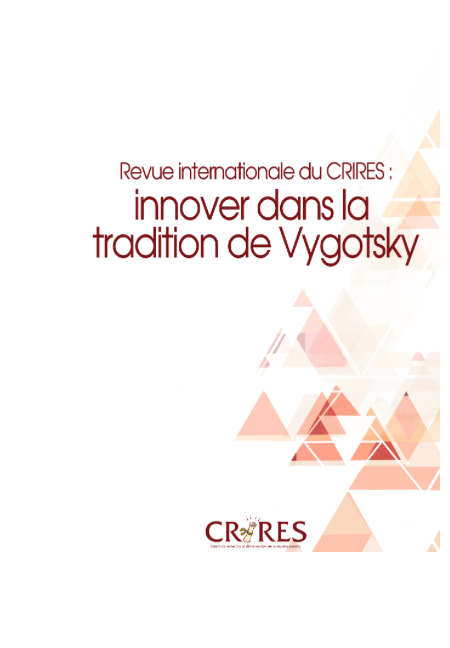La médiation dans le contexte de l’apprentissage d’une langue seconde
DOI :
https://doi.org/10.51657/ric.v5i2.51251Mots-clés :
médiation, système d’activité (SA), théorie de l’activité (CHAT), apprentissage d’une langue seconde, classe de languesRésumé
L’article proposé se veut une recension des écrits traitant de la théorie historico-culturelle de l’activité (CHAT) qui s’inscrit dans la recherche en classes de langues. Plus précisément, la revue de la littérature aborde la médiation dans le contexte de l’apprentissage d’une langue seconde. Concept introduit par Vygotsky (1978) et repris par des chercheurs tels qu’Engeström (2015) et Prenkert (2010), le concept de médiation est souvent présenté par des chercheurs en classe de langues sans pour autant être clairement opérationnalisé. Issus de cette constatation, les objectifs de cet article consistent en la redéfinition du concept de médiation, la circonscription de son rôle dans le système d’activité, la description de ses apports dans les recherches en classe de langues et la mise en lumière de ses nouvelles applications. Nous effectuons une revue de la littérature narrative issue de bases de données (LLBA, ERIC, EBSCO, PsycNET, SOFIA) et de critères d’inclusion. Les textes sur lesquels s’appuie cette revue sont empiriques et opérationnalisent la médiation en contexte. L’analyse des textes retenus met de l’avant une définition partagée de la médiation et une idée commune quant au rôle de la médiation en classe de langues relié à la compréhension des éléments médiateurs du système d’activité (SA). Finalement, plusieurs apports de ces textes sont dégagés : (1) le double rôle de la langue en tant que médiatrice et objet, (2) la médiation par les stratégies d’apprentissage, (3) le rôle médiateur de la culture de classe et (4) l'utilisation de nouveaux artéfacts en classe.
Références
Albusaidi, S. (2019). Using Activity Theory to explain how a student learns in an internationalised classroom from a sociocultural perspective. Journal of Language Teaching and Research, 10(6), 1142-1149. http://dx.doi.org/10.17507/jltr.1006.02
Cho, H. (2017). Synchronous web-based collaborative writing: Factors mediating interaction among second-language writers. Journal of Second Language Writing, 36, 37–51. https://doi.org/10.1016/j.jslw.2017.05.013
Donato, R., & McCormick, D. (1994). A sociocultural perspective on language learning strategies: The role of mediation. Modern Language Journal, 78(4), 453–464. https://doi-org.acces.bibl.ulaval.ca/10.2307/328584
Engeström, Y. (1987). Learning by expanding: An activity-theoretical approach to developmental research (1ère ed.). Cambridge University Press. https://doi.org/10.1017/CBO9781139814744
Engeström, Y. (2015). Learning by expanding: An activity-theoretical approach to developmental research (2ième ed.). Cambridge University Press. https://doi.org/10.1017/CBO9781139814744
Fajardo, G. R., & Torres-Guzmán, M. E. (2016). "Now I see how my students feel": Expansive learning in a language awareness workshop. Language Awareness, 25(3), 222–240.https://doi.org/10.1080/09658416.2016.1179745
Ganem-Gutierrez, G. A. (2014). A sociocultural theory approach to the design and evaluation of 3D virtual world tasks. In M. Gonzalez-Lloret & L. Ortega (Eds.), Technology-mediated TBLT: Researching technology and tasks (pp. 149-182). John Benjamins. https://doi.org/10.1075/tblt.6
Ganem-Gutierrez, G. A. (2018). Collaborative activity in the digital world. In J. P. Lantolf, M. E. Poehner, & M. Swain (Eds.), The Routledge handbook of sociocultural theory and second language development (pp. 391-408). Routledge. https://www.routledge.com/The-Routledge-Handbook-of-Sociocultural-Theory-and-Second-Language-Development/Lantolf-Poehner-Swain/p/book/9781138651555
Herazo, J. D., Davin, K. J., & Sagre, A. (2019). L2 Dynamic Assessment: An Activity Theory perspective. The Modern Language Journal 103(2), 443-458. https://doi.org/10.1111/modl.12559
Igira, F. T., & Gregory, J. (2009). Cultural Historical Activity Theory. In Y. K. Dwivedi, L. Banita, M. D. Williams, S. L. Schneberger, & M. Wade (Eds.), Contemporary theoretical models in information systems (pp. 434-454). IGI Global.
Lantolf, J. P., Poehner, M. E., & Thorne, S. L. (2020). Sociocultural theory and L2 development. In B. VanPatten, G. D. Keating, & S. Wulff (Eds.), Theories in second language acquisition: An introduction (3rd ed., pp. 223-247). Routledge.
Leontʹev, A. N. (1978). Activity, consciousness, and personality. Prentice Hall. https://www.worldcat.org/title/activity-consciousness-and-personality/oclc/3770804
Liang, X. (2009). Investigating mediations in student activities in an English immersion context in mainland China. English Language Teaching, 2(4), 38-50. 10.5539/elt.v2n4p38
Lin, C., Lin, V., Liu, G., Kou, X., Kulikova, A., & Lin, W. (2020) Mobile-assisted reading development: A review from the Activity Theory perspective. Computer Assisted Language Learning, 33(8), 833-864. https://doi.org/10.1080/09588221.2019.1594919
Loewen, S. (2020). Introduction to instructed second language acquisition (2ième ed.). Routledge. https://www.routledge.com/Introduction-to-Instructed-Second-Language-Acquisition/Loewen/p/book/9781138671782
Lompscher, J. (2006). The cultural-historical development of Activity Theory: Some aspects of development. In P. Sawchuk, N. Duarte, & M. Elhammoumi (Eds.), Critical perspectives on activity: Explorations across education, work, and everyday life (pp. 35-51). Cambridge University Press. https://www.cambridge.org/ca/academic/subjects/psychology/cultural-psychology/critical-perspectives-activity-explorations-across-education-work-and-everyday-life?format=HB
Luk, J. C. M. (2013). Forms of participation and semiotic mediation in board games for second language learning. Pedagogies: An International Journal, 8(4), 352–368. http://dx.doi.org/10.1080/1554480X.2013.829279
Niu, R., Lu, K., & You, X. (2018). Oral language learning in a foreign language context: Constrained or constructed? A sociocultural perspective. System, 7(4), 38-49. https://doi.org/10.1016/j.system.2018.02.006
Prenkert, F. (2010). Tracing the roots of activity systems theory: An analysis of the concept of mediation. Theory & Psychology, 20(5), 641-665. https://doi.org/10.1177/0959354310375329
Razfar, A., Licón Khisty, L., & Chval, K. (2011). Re-mediating second language acquisition: A sociocultural perspective for language development. Mind, Culture, and Activity, 18(3), 195–215. https://doi-org.acces.bibl.ulaval.ca/10.1080/10749030903494427
Roth, W. (2007). On mediation: Toward a cultural-historical understanding. Theory & Psychology, 17(5), 655-680. https://doi.org/10.1177/0959354307081622
Sannino, A., Daniels, H., & Gutiérrez, K. D. (2009). Learning and expanding with activity theory. Cambridge University Press.
Storch, N., & Sato, M. (2020). Comparing the same task in ESL vs. EFL learning contexts: an activity theory perspective. International Journal of Applied Linguistics, 30(1), 50–69. https://doi.org/10.1111/ijal.12263
Vosburg, D. (2017). The effects of group dynamics on language learning and use in an MMOG. CALICO, 34(1), 58–74.
Vygotsky, L. S. (1978). Mind in society: The development of higher psychological processes. Harvard University Press. https://www.hup.harvard.edu/catalog.php?isbn=9780674576292
Téléchargements
Publié
Numéro
Rubrique
Licence
© Robin Couture-Matte, Catherine Daigle, Ingrid Chabot 2022

Cette œuvre est sous licence Creative Commons Attribution - Pas d'Utilisation Commerciale - Pas de Modification 4.0 International.

